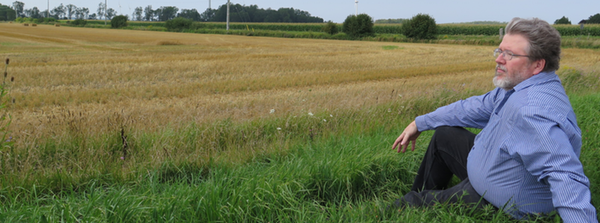Heads & Tales: Story in An Age of (dis)Information
“I suspect that Walter Benjamin, should he return, shuddering, to our era, would protest the sirens urging us toward the shoals of some epic chimera of greatness or defensive unity. I think he would also resist refuge at some cozy preindustrial hearth or in some rewilded grove. I wonder what he would make of successor narratives to the novel, the newspaper, or the psychoanalytic case; successors that no longer provide maps of modernity for our own navigation, but instead en-map and entrap and make us complicit in a psychographic reality that cares for and monetizes our fears and desires and avoidances?”—William Ramp
Small Things Recollected
By William Ramp

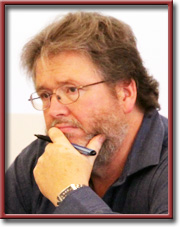 LETHBRIDGE, ALBERTA Canada—(Weekly Hubris)—February 2017— There are times a writer needs to step aside and hand on another’s voice and words. For me, this month, that other is Walter Benjamin, the German Jewish philosopher, cultural critic, and journalist who died trying to escape Vichy France in 1940. In October 1936, he published, in the journal Orient und Okzident, a review essay titled “The Storyteller: Reflections on the Works of Nikolai Leskov.”
LETHBRIDGE, ALBERTA Canada—(Weekly Hubris)—February 2017— There are times a writer needs to step aside and hand on another’s voice and words. For me, this month, that other is Walter Benjamin, the German Jewish philosopher, cultural critic, and journalist who died trying to escape Vichy France in 1940. In October 1936, he published, in the journal Orient und Okzident, a review essay titled “The Storyteller: Reflections on the Works of Nikolai Leskov.”
An essay and a story are different narrative forms, of course, though essays may contain or refer to stories. Reviled by generations of students who have had the form without spirit imposed on them in thousands of assignments, the essay has come to mean a short piece of writing in which one attempts to explain or prove a point, or to answer a question and, in so doing to “cover” some circumscribed body of literature.
However, etymology of the term points to something more playful, chancy or perhaps warlike: the French verb essayer, to venture or to try.
In the solitude of his tower room, Michel de Montaigne (1533-1592) wrote the fat volumes of the Essais that first wedded this literary form to modern individualism—or so his modern readers later said. Eric Auerbach wrote that “[a]mong all his contemporaries, Montaigne “had the clearest conception of the problem of man’s self-orientation; that is, the task of making oneself at home in existence without fixed points of support.”
“I am myself the matter of my book,” Montaigne wrote, helpfully, and commentators still debate the extent, direction, volubility, reserve, and evasions of his essayistic self-making. He wrote on topics that were no longer formulaic or conventional (though some do betray vestiges of the concerns of Scholastic philosophy) but, rather, conversational, anecdotal, and idiosyncratically encyclopedic. They read as if he is telling us things in person, rather than writing alone.
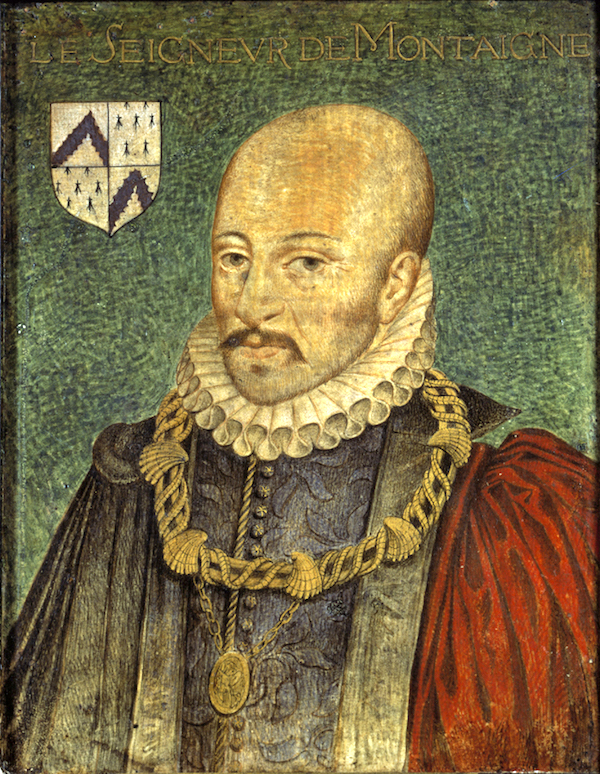
In the Essais, Montaigne gives us himself as a protagonist both within and apart from the early modern European world, as a seeker of refuge, as a protagonist of self-reflection on behalf of us, his individual readers. But he attempts to make meaning of his own life and ours from observations like those we might make, in a way that builds a model of mutual recognition; of friendship.
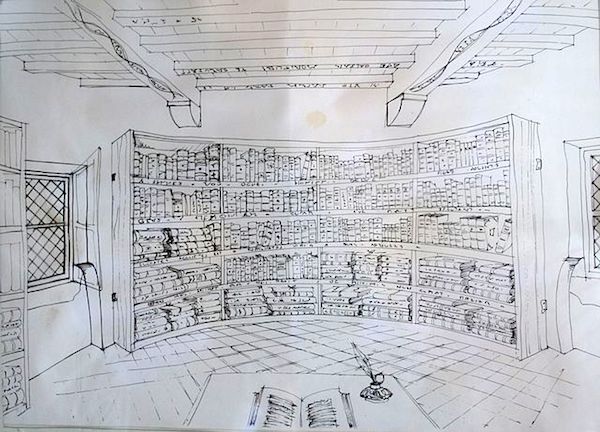
Thus, to try something out in essay form implies the existence of a social context in which this is done, even if eventually only in the attenuated form of what came to be called the Republic of Letters. As practiced by Montaigne, the essay still evidences kinship with oral narration in a post-medieval world. His writing built on mundane acts of observing, experiencing, talking, or reading; his reflections on these were first communicated in a particular place and time; his readers follow his words, in a sense recapitulating his own itinerary of understanding, and he models a kind of writerly virtue that makes his essays in some sense proverbial, produced in a particular place and time, but giving counsel, despite their author’s modesty, for the ages.
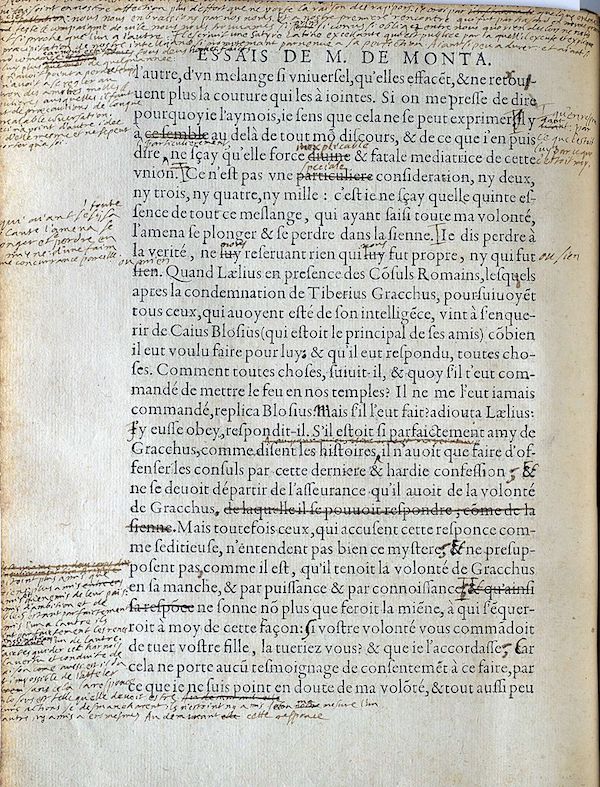
There is something of these qualities, also, in Walter Benjamin’s essay on storytelling.
Benjamin’s definition of the story form is quite particular. He argues that stories and storytelling may partake of myth but are grounded in particular, material practices. They brush against the timeless, but are temporal both in their structure and in their production. Story emerged (and diverged) from other narrative forms at particular historical moments. The storytelling traditions in which Benjamin was interested were those that marked the dawning social entanglements of commerce and mobility, and he emphasizes the distinctiveness of stories from their mythic, legendary, or epic backdrops in this light.
Traditional stories, he observes, tended to be told as if “from afar,” in time or space. In that sense, they maintain a certain distance. They may be told orally in intimate settings, but they retain a certain aura of unapproachability. At the same time, he links storytelling to concrete circumstances, and to particular and typical figures: the artisan and the itinerant traveler, for example. One made things; another carried them from place to place for exchange. One served to anchor stories in place while allowing them to roam in time; the other brought them from inaccessible or hard-to-imagine places to settle into new contexts of telling. Storytelling is itself an artisanal practice: a “coordination of soul, eye and hand which determines a practice.” However (in contrast to “artisanal” production of high-end or niche commodities today), the storyteller was less an author but someone who “could let the wick of his life be consumed by the gentle flame of his story.”
Stories, like the admonition of sages, gave counsel “for the many” that, applied to daily life, could become proverbial wisdom. Proverbs, Benjamin tells us, are ideogrammatic components of disintegrated stories: “[a] proverb is a ruin which stands on the site of an old story and in which a moral twines about a happening like ivy on a wall.” But unlike proverbs, the counsel afforded by stories was embedded in the recounted deeds or adventures of particular persons (even when these were stock figures). If stories descend from epics (as Benjamin claims), the story form had more to do with particular human responses to nature or to gods than with a mythic arc along which these were strung.
However, the art of storytelling refuses psychological explanation or a focus on selfhood, though traces of tellers may cling to stories made by a “slow piling on top of the other of thin, transparent layers.” Like artisanal work, telling and hearing stories well involves a kind of self-forgetfulness and time-forgetfulness. (The point of artisanal learning is to do better by becoming less self-conscious of what one is doing, which comes only with monotonous practice.) Storytelling demands a submission to time and a measure of boredom and constraint. Like traditional folk song, stories were often told in the course of repetitive and routine work with others. They could also be ambulatory; ways of passing the time while walking. Or they could be told in prisons, in places of refuge or exile (Boccacio’s Decameron springs to mind); places to which teller and hearer were bound, not only by walls and gates, but also by monotony.
There is a kind of paradox, then, in Benjamin’s description of the story form. On one hand, he situates story in relation to geographical mobility and trade, harbingers of modernity. On the other, he relates storytelling to constraint, to the long temporal discipline of practice, to monotonous, slow and repetitive passages of time. He contrasts this to the modern, economic approach to temporality, quoting Valéry on a coincidence between the declining importance of sustained effort and the fading idea of eternity. “Modern man no longer works at that which cannot be abbreviated.”
This is a crucial hinge in Benjamin’s essay. The timeliness and economy of modern information is linked to a process by which dying is “pushed out of the perceptual world of modernity,” and stowed in specialized institutional settings. Death loses its repetitive familiarity and materiality, its embeddedness in life, and becomes a demarcation; a cleavage between life and the story of a life; a moment at which a life can be subjected to full analysis; to explanation; to finality.
In this context, “the end of life imparts authority to the poorest wretch,” and the memories, experiences and maxims of the old and the dying gain a different kind of weight, not in light of the years they have lived but in relation to the conclusion they approach; the end-point of a biographical dossier. The lessons drawn may resemble old models of wisdom and moral instruction, but in modernity they apply to the manner in which individuals must now discover a particular and unique way through an uncertain and shifting future without a map.
The transition from the cultural dominance of story to that of information includes the development of the modern novel. The Decameron by Boccaccio is a signpost to its beginning. A collection of stories loosely bound together and situated by a dystopian frame narrative (the storytellers are taking refuge from an outbreak of the plague), The Decameron is neither novel nor a compilation of oral tales, but partakes a little of each. The stories told within it do not give traditional counsel but model new ways of navigating the circumstances of the commercial life of towns. In the European and North American contexts, the rise of the novel (and concurrently, of industrialization) challenged and, some argued, mortally wounded storytelling traditions. Instead of wise advice, novels gave a new middle-class culture a set of protagonists who were, like novel-readers, un-counseled, badly counseled or unable to counsel in the new and changing circumstanced they faced.
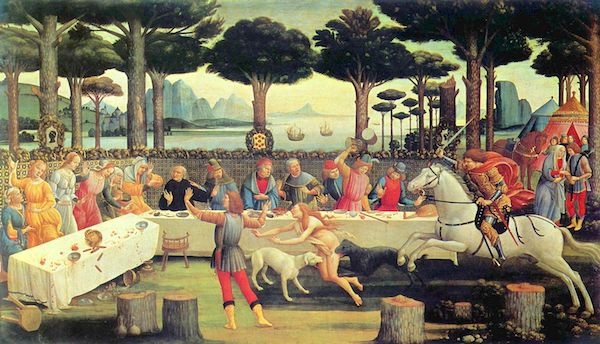
Benjamin suggests that the modern novel partakes of the same observational emphasis as story, but with a different outcome for its readers. Stories are listened to companionably, with the aim, if anything, of remembering and reproducing them; not extracting a truth and discarding the rest like a husk (nor preserving it for exhibition or scholarly autopsy as folklore). But novels are read alone; they are “devoured,” in Benjamin’s memorable term. “What draws the reader to the novel,” he says, “is the hope of warming his shivering life with a death he reads about.” The storyteller, by contrast, is a figure in which “the righteous man encounters himself.” These righteous are not equivalent to authors, protagonists, or solitary readers.
If the story, like the epic, still lives in the house of Mnemosyne, goddess of memory, the novel, says Benjamin, is homeless in modern time and space. The novelist “works melancholy from lives not fully lived;” the novel involves a struggle against time waged in terms of hope and memory, presenting a “unity of life grasped in retrospect.” It tends to deal in the meaning of life in individualized form; the retrospective shape of a life is the moral of the story, told from the perspective of its end.
Benjamin’s account of these historical shifts in narrative is arguably dated. It doesn’t say much about the proliferation of novelistic experimentation since the early 20th century. But these experiments —along with our contemporary concerns about datedness— are consequences of something about which Benjamin is prescient: the late-modern crisis of the novel was induced by the rise of a new narrative forms centered on “information”: scientific, commercial, and news communications, carried by specialist, mass, and now social media, and collected in museums, archives and databases.
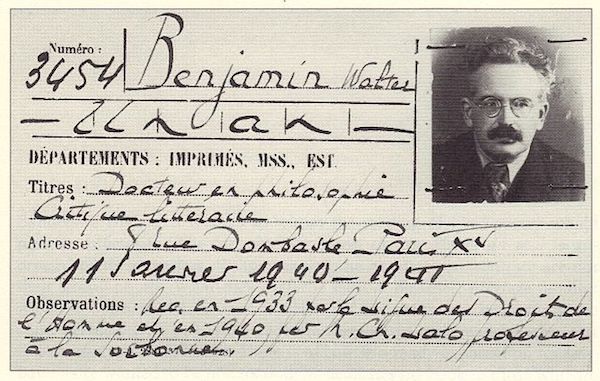
Contemporary journalists often claim that telling stories is at the core of what they do. But Benjamin asserts that news is governed by different imperatives than traditional storytelling. News is informational; information focuses on the fleetingly proximal and the temporal. Information is more valuable—more relevant— the closer it is in time, in geographical location, or to a reader’s interests. Information dates quickly; newness is its necessity. In an age of information, a tale from afar or the past is no longer guaranteed intrinsic validity, except, perhaps, as an object of hermeneutic, structural, or anthropological study. Information is consumed somewhat like daily medicinal doses: its effect doesn’t outlast the day. Stories, by contrast, are repeated; they deal in events but not novelty; nor is their point to convey or deliver something “economically.”
Information is also more valuable the more transparent it is; the more it is “understandable in itself,” the more it is promptly verifiable; the easier it is to consume. Ironically, these criteria fit both the dissemination of scientific information and also modern religious evangelization.
Protestant fundamentalism adopted a modernized way of reading the Bible. It reduced a compendium of once-oral tales, song, poetry, proverbs, letters, and allegorical visions to the “plain sense” of proof-texts as something akin to naturalistic observation, and read its narratives as equivalent to news events. The Good News, in other words, has become something like the morning news, and if the plain sense of Scripture is not plain enough, then its informational value can be enhanced, like the background news story, by remedial explanation. “Nothing any more comes to us without being shot through with explanation,” Benjamin notes.
Benjamin sees in story a mode of communication in which the “psychological connections” of a narrative are not forced on readers or hearers but left to them to interpret in a process by which a tale slowly gains “amplitude;” a quality foreign to information. Both stories and information are applicable to everyday life, but the applicability of story is neither standardized nor guaranteed.
Today, traditional stories today are often treated as artifacts of historical, literary, and social-scientific explanation: their shape tells of cultural transmission and divergence, though their contents, once reviled by professional historians, may now be accorded grudging respect as factual (viz the “amazing” accuracy now attributed to stories of Pacific Coast First Nations which reliably describe and date a tsunami at the turn of the 18th century).
It would be relatively easy to read Benjamin’s chronology of the deposition and succession of different narrative forms nostalgically; a tale of an old world lost. But it would be equally easy to read it as an evolutionary epic. That’s no accident: accounts of loss are the shadow side of the claimed inevitability of evolutionary progress. Narrative is often represented as a universally human capacity, rooting a tree of subdividing types. Benjamin himself links story, history, and the modern novel to older narrative forms such as legend, chronicle, and epic. Historical or biographical novels have departed the cosmic span of the epic, though they may cast individual protagonists, groups, or eras in a decidedly epic light.
Similarly, history descends from but divides itself from chronicle. Whereas history seeks evidence and is explanatory, chronicle presented “models of the course of the world” which were often inscrutable. In chronicle, interpretation was “not concerned with an accurate concatenation of definite events, but with the way these are embedded in the great inscrutable course of the world.” Medieval chronicles of the divine plan of salvation did not bring salvation close in clear explanatory formulae, as modern fundamentalism tries to.
Stories may tell of human participation in epic events, but Benjamin argues that storytelling favored the naturalistic over the eschatological. Story was typically situated in the “household of humanity” where arbitrary misfortune and death was a constant companion. But unlike the modern novel or short story, the significance of uniquely individual life or death is not storytelling’s stock in trade. The protagonists of story, even when they are historical, take on the characteristics of stock figures.
Nonetheless, the characters that populate stories are often lively, engaging, and quick-witted. Fairy tales, for example, tell of figures who meet, subvert, or escape the forces of a mythical or natural world with cunning and in high spirits. As Robert Darnton points out, the mythical world of fairy tales closely paralleled the real material and political conditions under which the medieval and early modern peasantry lived, and figures like Jack (of beanstalk fame) can edge very close to the modern image of the entrepreneur. Fairy tales involve a sort of liberation from myth. In them, depravity can flip into saintliness; a small-time rascal can be a vehicle for the voice of nature. They are, Benjamin claims, actually disenchanting, counterintuitive though that might seem to modern rationalists.
With this claim, Benjamin upends Modernist readerly expectations. There is a nostalgic tendency to represent story as timeless, traditional, and lost; a broken vessel of Arcadian wisdom begging for restoration. But to read “The Storyteller” in such terms is to neglect Benjamin’s complex approach to history and to the force which propels us backward into the future: “progress” produces both modernity and nostalgia for the premodern and, eventually, undermines both. One could make a case that medieval and early-modern fairy tales, as well as the stories of the Decameron, helped prepare us, unseeing, for modern commerce and for individualism.

The need to link and narrate a chain of events remains as strong as ever today; perhaps that need is what is universal about story and other communicative forms. But today, the term “story” has taken on a revived and much broader vernacular meaning than the one assigned to it by Benjamin. It has become a marker for narrative-commodities of many sorts; much like Apple Corporation’s use of the term “song” for any musical item of a certain length, including a symphonic movement.
So, for example, the social network service Storify now announces that the “Livefyre Engagement Cloud just got bigger, better,” because “Storify 2 gives you the tools to create the best evergreen and live blog stories, uniting traditional storytelling with engaged audiences.” It promises “a story for every use-case”: “breaking news,” “live blogging,” “hashtag campaigns,” and “Q&A.”
Social media platforms contain oceans of mini-narratives and story elements washing back and forth in waves of sharing and modification. These are soaked in updated versions of many of the same topics and themes that Benjamin ascribed to the high-modern novel: the navigational travails of individuals without maps in worlds that juxtapose intimacies and anonymity; emplacement and exile; stuckness and portability; individualization and permeability; isolation and connectivity.
In part, this revived and reconfigured desire for narrative, along with nostalgia for its older forms, may reflect a hunger stimulated by a diet skewed to information.
In an earlier column, I noted that providing more scientific information and rational explanation concerning the climatic crisis looming over the human world seemed to have little effect any more on the un-persuaded. I suggested that the problem with the communicative strategies employed by too many scientific rationalists was a fatal assumption that the obviousness of verifiable facts and rational explanation would suffice to carry the day. I argued instead that what was needed was something to make the facts sing: a moral or even cosmic narrative to counter those weaponized by denialism.
What I was suggesting was something discomfortingly close to the strategy of the Trump electoral campaign, which employed and deployed narrative bits like the slogan “Make America Great Again” to call up epic ghosts for chanting audiences; dreamscapes, simulacra of Horatio Alger stories; faux-legends of monsters at the door.

Social and mass media are also full of “informational” content that displays the same restless pursuit of immediacy noted by Benjamin. Facebook’s Timeline, for example features a constantly-updated scrolling list of undifferentiated “news” items with minimal searchability. Explanation is also loudly and urgently everywhere.
As I write, a prominent psychologist has gone public with a diagnosis made in part from media materials of a personality disorder allegedly suffered by the current occupant of the Oval Office, igniting yet another predictable twitterstorm. For months, the latter’s electoral victory has been subjected to a rainbow of analyses and opinionated memes. Ideological, geographical and social proximity exercise ever more sway over what gets noticed, and by whom; the silo effect of social media algorithms now creates entire proximal worlds tailored to our individualized profiles and constructed out of our “likes,” clicks, and purchases.
But there is one yawning difference between the era of the informational narrative that Benjamin named in 1936 and the one we live in now. The age of public information and explanation is crumbling in its turn. Or, rather, a ghostly shadow of it has stalked it, eviscerated it, and thrown its cloak over its corpse. Ironically, it was already doing so as Benjamin wrote, in exile from Naziism, in France. We North Americans are now being told that we live in a “post-truth” era, and certainly the shameless lies emerging from the Trump administration and its allies seem to bear that out. But the lies often take the form of information and explanation: they simulate science and journalism and public knowledge. They seek to cloak realities by presenting themselves as transparent in the same way that “objective” scientific or news reportage is supposed to be. They make claims to relevance in relation to our interests, genuine or imagined.
It is precisely this close simulation, along with the hyper-production made possible by digital media, that allows fake news and fake science to threaten the inherent validity of information itself. Postmodern thought, a couple of decades ago, was (rather unfairly) made out to be a bogeyman assaulting rational and fact-based explanation. Today, though, positivism and rationalism are back in distorted and monstrous forms. The corpse of information grinningly promises facts —or alt-facts if you will— along with opinion disguised as explanation. These transparently convey the “realities” of our predetermined choosing.
Behind the public realm, though, facts and explanations can still command serious value. Data may be manipulated to fit narrative fragments retailed to consumers but, in other forms, it can also be sold as a means of production for advertising and public-relations industries. No more horrifying example trumps a recent investigative report by two German journalists on the gathering of vast amounts of psychographic data, much of it innocently and voluntarily submitted, on virtually every individual (and now identifiable) American citizen, for the purposes of developing intimately-targeted political and commercial messaging for hire.
In other words, we can now be given the stories of our lives through an information-gathering process that envelops and mediates us invisibly, individually, but totally, and encouraging us to see that gift as something we give ourselves. Which in a sense, we do.
I suspect that Walter Benjamin, should he return, shuddering, to our era, would protest the sirens urging us toward the shoals of some epic chimera of greatness or defensive unity. I think he would also resist refuge at some cozy preindustrial hearth or in some rewilded grove. I wonder what he would make of successor narratives to the novel, the newspaper, or the psychoanalytic case; successors that no longer provide maps of modernity for our own navigation, but instead en-map and entrap and make us complicit in a psychographic reality that cares for and monetizes our fears and desires and avoidances? I wonder, too, what response he might have to those who call frantically for a return to the public square, to scientific proof, to real facts, vetted claims and rationalist explanation? Would he sense that such efforts to restore the ruins of the era of information will not return us to a 20th-century elite-institutional definition of sanity, but to something new, different, perhaps brave, perhaps doomed, likely only half-understood?

Between February 13 and 15, 1945, the city of Dresden, architectural jewel of the Saxon kings and crammed with refugees, was set alight by Allied bombers. On the 15th, the burnt-out hulk of the landmark Church of Our Lady (Frauenkirche), rumored to have been a storage-place for highly-flammable reels of Nazi propaganda, collapsed in a roar of superheated stone and dust. The rubble pile was grassed over and became an artificial hill until a multinational project began in the 1990s to uncover it, sort and classify the shards, and rebuild the church exactly as it was, stone by stone. That project is complete now. But what stands there as a result? The old church or the new? And what does one make of cardboard advent calendars sold every December, showing scenes of the church in glowing winter kitsch, with all reference to burned and bloated bodies absent? What sort of return do they signify? What sort of story do they lend themselves to?
I leave you with one of Benjamin’s most famous narrative fragments. It’s not a full story and it contains no clever Jack besting giants or beasts. It offers no instruction in virtue or survival. It tells no tale from afar. It is prematurely aged; it has been quoted and shared and commented on enough that it is already tattered and hackneyed. The storm from paradise it refers is no longer named Progress, because Progress lies spent in the rubble before us as we are pulled away.
Walter Benjamin: “A Klee painting named Angelus Novus shows an angel looking as though he is about to move away from something he is fixedly contemplating. His eyes are staring, his mouth is open, his wings are spread. This is how one pictures the angel of history. His face is turned toward the past. Where we perceive a chain of events, he sees one single catastrophe which keeps piling wreckage upon wreckage and hurls it in front of his feet. The angel would like to stay, awaken the dead, and make whole what has been smashed. But a storm is blowing from Paradise; it has got caught in his wings with such violence that the angel can no longer close them. The storm irresistibly propels him into the future to which his back is turned, while the pile of debris before him grows skyward. This storm is what we call progress.”
What now to call the returning storm, and how to meet it?
A generation before Benjamin, the sociologist Max Weber gave this response: “We shall set to work and meet the ‘demands of the day,’ in human relations as well as in our vocation. This, however, is plain and simple, if each finds and obeys the demon who holds the fibers of his very life.”
Today, the words of that second sentence give pause: the plain and simple is gamed.
Make of this what you can, or perhaps (as Christ said to his betrayer), what you must.

Notes & References
“. . . a review essay titled “The Storyteller: Reflections on the Works of Nikolai Leskov . . .” Reprinted in Dorothy J. Hale, ed., The Novel: An Anthology of Criticism and Theory 1900-2000. Malden, Mass.: Blackwell Publishing, 2006.
“. . . commentators still debate the extent, direction, volubility and reserve of his essayistic self-making . . .” Adam Gopnik, “Montaigne on Trial: What do we really know about the philosopher who invented liberalism?” The New Yorker, January 16, 2017.
“. . . in a way that builds a model of mutual recognition; of friendship . . .” John O’Neill, Essaying Montaigne: A Study of the Renaissance Institution of Writing and Reading. Liverpool: Liverpool University Press, 2001
“. . . a kind of virtue that makes his essays in some sense proverbial, produced in a particular place and time, but giving counsel . . .” Sarah Bakewell, How to Live: A Life of Montaigne in One Question and Twenty Attempts at an Answer. New York: Other Press, 2011
“They may be told orally . . .” The different narrative forms of the epic, legend, chronicle and story all have a strong association with oral tradition: Alfred Lord and Millman Parry, for example, made the case that epic poems like The Odyssey and The Illiad may have been subject to oral transmission for hundreds of years before (and after) entering the realm of written text. On the other hand, the novel the historical account, and information tend to be associated with print. But they can cross back and forth. Benjamin’s essay is a review of stories written and published by a modern author. And as Darnton points out, “traditional” stories have circulated in and out of print over the past five hundred years; collected and published in book compilations, they re-enter oral tradition via readers who become tellers. See Robert Darnton, “Peasants Tell Tales: The Meaning of Mother Goose,” in Darnton, The Great Cat Massacre and Other Episodes in French Cultural History. New York: Basic books, 2009.
“They could also be ambulatory; ways of passing the time while walking.” I am indebted for this insight to an M.A. thesis (University of Lethbridge, in progress) by Emily Kirbyson. Citing Juanita Sundberg, Kirbyson notes that “trail walking is intertwined with storytellings that ‘call forth and enact connections between people, place, and practices in time and space’.” See also J. Sundberg, 2014 “Decolonizing posthumanist geographies,” cultural geographies 21(1), 33–47.
“As Robert Darnton points out, that mythical world closely paralleled the real conditions . . .” See Robert Darnton, “Peasants Tell Tales: The Meaning of Mother Goose,” in Darnton, The Great Cat Massacre and Other Episodes in French Cultural History. New York: Basic books, 2009.
“In an earlier column, I myself noted . . .” William Ramp, “Communicating the Fall,” Weekly Hubris, September 29, 2016.
“. . . a prominent psychologist has gone public with a diagnosis made from media materials . . .” Susan Milligan, “Temperament Tantrum.” U.S. News & World Report, January 27, 2017.
“No more horrifying example trumps a recent investigative report by two German journalists . . .” Hannes Grassegger and Mikael Krogerus, “The Data that Turned the World Upside Down,” Motherboard (Vice.com), September 27, 2017.
“… the burnt-out hulk of the landmark Church of Our Lady …” See Wikipedia, “Dresden Frauenkirche,”.
“. . . one of Benjamin’s most famous narrative fragments . . .” Walter Benjamin, “On the Concept of History,” trans. Dennis Redmond. Marxists.org, 2005.
“A generation before Benjamin, the sociologist Max Weber gave this response . . .” Max Weber, “Science as a Vocation,” in H.H. Gerth and C. Wright Mills, eds., From Max Weber: Essays in Sociology. New York: Oxford University Press, 1946.

About the Illustrations
Image 1: Wikimedia Commons. Public domain. https://commons.wikimedia.org/wiki/File:Millais_Boyhood_of_Raleigh.jpg#mw-jump-to-license
Image 2: Wikimedia Commons. Public domain. https://commons.wikimedia.org/wiki/File:Montaigne-Dumonstier.jpg
Image 3: Wikimedia Commons: image by Mcleclat, 2010. Licensed under Creative Commons Attribution-Share Alike 3.0 Unported, 2.5 Generic, 2.0 Generic and 1.0 Generic license. https://commons.m.wikimedia.org/wiki/File:Librairie_Montaigne1.jpg
Image 4: Gallica Digital Library (digital ID bpt6k11718168/f156), via Wikimedia Commons. Public domain. https://commons.wikimedia.org/wiki/File:Montaigne_Essais_Manuscript.jpg
Image 5: Wikimedia Commons via The Yorck Project: 10.000 Meisterwerke der Malerei. DVD-ROM, 2002. ISBN 3936122202. Public Domain. https://commons.wikimedia.org/wiki/File:Sandro_Botticelli_075.jpg
Image 6: Wikimedia Commons, Public domain. https://commons.wikimedia.org/wiki/File:BenjaminBnF.jpg#mw-jump-to-license
Image 7: Wikimedia Commons, via Flickr. Licensed under the Creative Commons Attribution-Share Alike 2.0 Generic license. https://commons.wikimedia.org/wiki/File:Make_America_Great_Again_outdoor_banner_on_roadside_in_California.jpg
Image 8: http://rarehistoricalphotos.com/ruins-dresden-1945/
